|
Place Name
Inamuragasaki Point:
A hill that runs south from Gokurakuji (極楽寺) and juts into the sea where it forms a point is called Inamuragasaki. The name, inamura (稲むら), is based on the shape of stacked bundles of harvested rice plants.
Shichirigahama Beach: A gentle coast between Inamuragasaki and Koyurugimisaki (小動岬) in Koshigoe (腰越) is called Shichirigahama. Shichi-ri means seven ri (里), one ri being about 4 kilometers in an old system of Chinese measurement. The beach is far from being that long, but the name may be appropriate nevertheless, for Shichirigahama is Kamakura's longest beach.


Location: To reach this site, first take the road that leads from Harisuribashi Bridge (針磨橋) to Inamuragasaki, then cross the Enoden Line tracks. Ahead on the right-hand side you will find a stone monument and a tall pine tree in a space carved in the cliff. The monument is inscribed with the characters Namu-Myoho-Rengekyo (南無妙法蓮華経) and states that in 1271 Nichiren (日蓮, 1222-82) hung his robe here on a pine tree. In that year, while being taken to the execution grounds at Tatsunokuchi (竜ノ口) near Enoshima, Nichiren paused here and removed his robe. After hanging it on a pine tree, he is said to have exclaimed that it was blasphemous indeed to stain a holy robe with his blood. The original pine tree is long since dead, and it is not known how many other pines have been re-planted over the centuries, but one now stands here in this arranged space together with a monument.


Location: Getting here entails crossing the Enoden Line tracks in the direction of the beach and walking some 50 meters until you come to a three-way intersection. On the corner is Juichininzuka Mound, a monument for eleven warriors, surrounded by low stone pillars. Story: The monument was erected in memory of Odate Jiro (大館次郎) and eleven of his followers. (The inscription incorrectly adds the character "又" to his name:又次郎.) In 1333, when imperial troops headed by Nitta Yoshisada (新田義貞, 1301-38) attacked Kamakura, Odate, a general of the Nitta forces, rushed to Gokurakujizaka Pass with a large number of his soldiers. Evading a hail of logs and rocks from both sides of the pass, they broke through the Hojo (北条) defense and headed towards Yuigahama, where the enemy awaited. Faced with a counterattack by the troops of Homma Yamashirozaemon (本間山城左衛門) of the Hojo side, Odate's army was forced to retreat to Gokurakuji (極楽寺), where Odate and most of his men were killed near the Inasegawa River (稲瀬川). In the end, only eleven of Odate's men were left, but rather than give up and surrender they chose to take their own lives with their own swords. The eleven are said to have been buried here, and a statue of Eleven-faced Kannon (十一面観音菩薩, Juichimen Kannon) was erected to their memory under the name Juichininzuka, "Mound of the Eleven." Generally, tsuka (塚, also pronounced zuka) refers to a tombstone, but this particular tsuka was erected later as a memorial.


Location: At Inamuragasaki Point Site: An area that encompasses Shichirigahama Beach and Inamuragasaki Point was arranged as a park called Kamakura Kaihin Koen. The view from the top of its hill takes in the gently curving Shichirigahama Beach, Enoshima Island with Mt. Fuji in the background, the Hakone Mountain Range and the Izu Peninsula. On a clear day, even Izu Oshima Island is visible. 

A stone monument at the park entrance marks the site of General Nitta Yoshisada's military campaign in 1333. Nearby, another stone monument bears a poem written by Emperor Meiji (明治天皇, 1852-1912). 

A flight of stone steps leads up to the cape section of the park where there is a rest house and a stone monument in honor of Dr. Robert Koch. Dr. Koch, a medical scientist and the founder of modern bacteriology in Germany, made a significant contribution to humankind through his discovery of the TB bacterium and the invention of treatment for tuberculosis. Kitazato Shibasaburo (北里柴三郎, 1853-1931), a bacteriologist who studied under Dr. Koch in Germany, gained fame for his discovery of the bacterium that causes tetanus. In 1905 he invited Dr. Koch to come to Japan, where he visited Mt. Ryozen (霊仙山) in the Gokurakuji area. A monument marking this event was originally erected on that mountain, but as the site was rarely visited, the monument was transferred here in 1983 on the occasion of the centennial anniversary of the discovery of the tubercle bacillus in 1882. 
In the beach section of the park is a monument that marks the occurrence of a 1910 tragedy in which a number of students drowned. In the form of a statue, it depicts two brothers, with the younger clinging to the elder, who is shown scanning the water for help while trying to save his brother from drowning. Sculptured in bronze by Suganuma Goro (菅沼五郎), the statue was erected in 1964. 

Twelve students actually drowned that day, all of them from Zushi Kaisei Junior High School (逗子開成). High waves capsized their boat on their return to Zushi from a training session near Enoshima Island. The day had been cold with a strong westerly wind that strengthened towards afternoon. The students and one elementary school child were aboard a cutter and desperately tried to return to land, but off the coast of the Yukiaigawa River (行合川) the boat capsized. Later on the same day, a fishing boat found one boy drifting but alive, although he died soon after. The others were found dead over the next few days, among them a student holding his younger brother tightly in his arms. The monument represents his desperate efforts to save him. The twelve bodies were brought to their school, where a funeral service was held. A song in their memory, Mashiroki Fuji no Ne (真白き富士の嶺), composed by Ms. Misumi Suzuko (三角錫子), a teacher at Kamakura Jogakko (now Kamakura Jogakuin Junior-Senior High School, 鎌倉女学院), is still remembered and sung by many people.


Inamuragasaki Point and General Nitta Yoshisada (新田義貞) Location: Some 300 meters southeast of Inamuragasaki Station on the Enoden Line. Site: The shape of the Point, in conjunction with the connecting hill from Gokurakuji, gives the appearance of a stack of harvested rice bundles (inamura in Japanese), thus accounting for the name. According to the Azuma Kagami (吾妻鏡), the area here is said to have been the western border of Kamakura, which could mean that the range of hills prevented people from easily traveling in and out of the city. Presumably, in those days, a narrow path skirted the foot of Inamuragasaki cliff. Story: A well-known story about Nitta Yoshisada's campaign is recorded in the Taiheiki (太平記), a fourteenth century military chronicle. In 1333, Yoshisada and his forces made their final attack on Kamakura, and rather than try to enter the city via Gokurakujizaka Slope he instead opted to march forward around the foot of the Point. The path there, however, proved to be not wide enough for passage. Moreover, the enemy was aboard large ships and ready to shoot should Yoshisada attempt to take the coast route. Yoshisada thereupon used the following tactic. Gathering all of his soldiers, he stood solemnly at the top of the cape and prayed for success, respectfully holding up before his eyes a golden sword given to him by Emperor Go-Daigo (後醍醐天皇, 1288-1339), then hurled it into the sea. The tide soon receded and the enemy ships were forced out into the offing. For the warriors from landlocked areas who had never seen the ocean, the sight of the ground suddenly appearing seemed so miraculous that they thought Yoshisada's prayer had been answered. Inspired, they attacked the city with renewed vigor, bravely charging enemy positions with loud battle cries. General Nitta, obviously, had known about the tides, and put that knowledge to good use. A less colorful story asserts that Yoshisada's forces proceeded along the path that skirted the cliff. Regardless of the truth of either story, it is a fact that the Hojo defeat and Yoshisada's victory were fatal to the Kamakura government of the time.
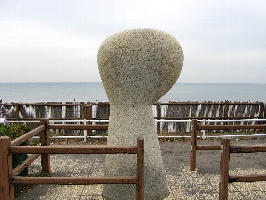

Monument for Nishida Kitaro (西田幾多太郎の歌碑) Location: Close to Ubagayatsu (姥ケ谷) Bus Stop between Kamakura Station and Enoshima Island. Site: A granite stone monument resembling a paper doll (teru-teru-bozu, てるてる坊主) customarily hung outside a window in hopes of bringing about good weather, stands on the roadside. The monument was erected in memory of Dr. Nishida Kitaro (西田幾多郎, 1870-1945), one of the most important philosophers of modern Japan. He strove to assimilate western philosophy and Buddhist thought to create a philosophy of his own. He was awarded the Order of Culture (文化勲章), and, until his death at the age of 75, continued writing at his home in Inamuragasaki. His pen name was Sunshin (寸心).


Yukiaigawa River (行合川) Location: Near Shichirigahama Station on the Enoden Line. Story: In 1271, Nichiren was arrested and later taken to Tatsunokuchi (竜ノ口) at Katase (片瀬) near Enoshima to be executed. At the moment the executioner began to raise his sword, the sky sent forth a flash of light so strong he was blinded and left unable to carry out his duty. He thereupon dispatched a messenger to inform the officials of this miraculous event, and on his way the man met, at this riverside, a messenger from the government carrying a message of pardon for Nichiren: hence, yukiai (行合い), "meeting each other." The water off the mouth of this river is unsafe due to the confluence of the river's flow and the Sagami Bay current.. In 1910, twelve students from Zushi Kaisei Junior High School lost their lives here while undergoing nautical training.
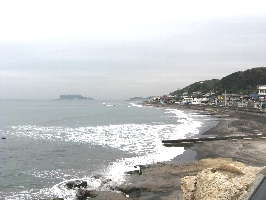

Shichirigahama offers an excellent view of Mt. Fuji and the Hakone and Izu mountain ranges. The beach is popular all year around among those who enjoy windsurfing and yachting but is not suitable for swimming owing to the rough and rocky seabed. At low tide, the exposed bottom gives the appearance of tatami mats (畳) laid out side by side and end to end. Since the middle of the Showa period (1926-1989), the surrounding area has been developed and now has such facilities as a municipal sewage disposal plant, an elementary school, and a senior high school, all helping to cope with a rapidly increasing population.


Location: Midway from Kamakura Koko Mae Station (鎌倉高校前) on the Enoden Line to Kamakura Koko itself is a steep slope called Nissaka. Story: The forces of Nitta Yoshisada advanced up this slope when they attacked Kamakura--hence the name Nittasaka (新田坂), which in time was corrupted to Nissaka. Another theory, however, says that since the slope faces south and receives much sunshine, it was named Nissaka, "sunny slope." Also in this area, but behind Kamakura Koko Mae Station is a graveyard that contains tombstones dedicated to those who died in the nearby sea.


Location: Between Kamakura Koko Mae Station and Shichirigahama Station on the Enoden Line, the single track divides into a double track so that a train bound for the Kamakura terminal and a train bound for the terminal in Fujisawa can pass each other. Kanearaizawa is located nearby. Story: Minamoto no Yoritomo (源頼朝, 1147-99) allegedly set up a checkpoint in the area in order to prevent his brother, Yoshitsune (義経, 1159-89), from entering Kamakura, and drove him back to Koshigoe. A passage in the Azuma Kagami also tells us that in 1182 Yoritomo made a round trip between Koshigoe Beach and Enoshima, then returned to his residence after viewing ushioumono (牛追物), a kind of sport in which mounted men chase and shoot calves. This area was large enough to have contained such a checkpoint and a ground for ushioumono as well as other facilities, such as an execution site. In 1221, Seikyu Goro Yukimori (清久五郎行盛) ordered the execution of Minamoto no Mitsuyuki (源光行) for having supported retired Emperor Go-Toba (後鳥羽上皇, 1180-1239), who had risen in revolt in the Jokyu Disturbance (承久の乱) in the same year. Minamoto Chikayuki (源親行), Mitsuyuki's son, implored the bakufu (幕府) to spare his father. On the day of the scheduled execution a letter of pardon was finally issued, and Chikayuki then rushed on horseback to his father at the execution site and saved him. Mitsuyuki is thought to be the author of the Kaidoki (海道記), a travel diary written in the Kamakura period, relating his journey on the Tokaido Road (東海道) from Kyoto to Kamakura, then back to Kyoto. The Shimpen Kamakurashi (新編鎌倉志), a book on the natural features, culture and history of Kamakura written in the Edo period (1603-1867), states that Shichirigahama produced iron sand of good quality, suitable for use in sharpening kitchen knives and other cutlery. Hence, this area was named Kanearaizawa, which literally translates as "Iron Sand Washing Mountain Stream."


Full name: Ryuozan (龍王山) Reikoji Temple Denomination: Nichiren sect Location: To reach Reikoji Temple, get off the Enoden Line at Shichirigahama Station and walk about 300 meters up the road that runs parallel to the Yukiaigawa River. Where the road forks, the Amagoibashi Bridge (雨乞橋) spans the river on the left. Turn left here, walk up the slope, and you will soon reach Tanabegaike Pond (田辺が池). A stone monument there marks the grounds of Reikoji Temple. If you take the lane at the foot of the cliff to the right, you will soon see the temple's Sammon Gate (山門) with Ryuozan (龍王山), the sango (山号) of the temple, written on the plaque. Grounds: A parking lot and a graveyard are behind the gate. Further behind is a flight of steps leading up the hillside. If you climb them, a statue of Nichiren, facing in the direction of Tanabegaike Pond, will come into view. 

The statue, called Kiureizo (祈雨霊像), shows Nichiren praying for rain. The lane here turns to the right and continues further up the hillside. The grounds, with their tall and dense trees, provide a sense of isolation despite the neighboring Shichirigahama residential area. 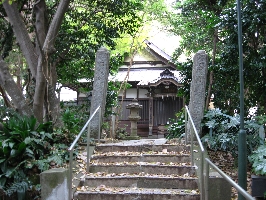
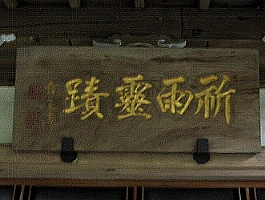
The Main Hall and a stone statue of Jogyo Bosatsu (浄行菩薩) to the left will be found at the top of the stairway. The characters 祈雨霊蹟 (Kiureiseki), which mean "sacred site of Nichiren's prayer for rain," appear in gold lettering on the plaque under the eaves of the hall, and is in the handwriting of General Kamimura Hikonojo (上村彦之丞), who contributed to the construction of Reikoji Temple. The Main Hall houses a statue of Nichiren. History: The modern history of the temple only dates back to the late Meiji period when a priest discovered a stone marker dated 1735. It indicated that this was the site of Nichiren's prayer for rain in 1271. The priest decided to build a new temple on the site because of its close association with Nichiren. Over the years, halls and statues were gradually added, and in 1957 the temple was formally established as Reikoji, afterwards expanding its grounds to include Ryuoden Hall, Shoin, and Sammon Gate. Story: In 1970, Reikoji Temple celebrated the 700th anniversary of Nichiren's miracle of the rain. The miracle refers to the summer of 1271 when there had been no rain since early spring, a long dry spell that caused considerable hardships for the local people. As regent, Hojo Tokimune (北条時宗, 1251-84) was distressed and requested Ninsho (忍性, 1217-1303), a priest at Gokurakuji Temple, to pray for rain. On a platform built in front of the Main Hall, Ninsho, accompanied by several score of priests began reciting sutras. The sound of bells, we are told, filled the grounds, and smoke from the incense filled the air. The chanting voices of all the priests created such a roar that the grounds are said to have trembled. Though Ninsho continued his prayers for seven days, no sign of rain appeared. He thereupon asked as many priests of his sect as were available to gather here, adding that if his prayers could not be answered, it would bring shame to his temple, and extended the period for another seven days. But all came to naught. Nichiren then took Ninsho's place and began reciting the Hokekyo (法華経), holding a copy in his left hand. He chanted from the first volume through the third, but the sun continued to shine. When he began the forth volume, however, vapor gradually rose, spreading everywhere like mist. By the fifth volume, the wind began to blow and the thunder to rumble. With the sixth volume, rain began to fall. Everyone in attendance chanted Namu-Myoho-Rengekyo (南無妙法蓮華経). The rain, it is said, lasted three days. Because of this miracle, the people were able to enjoy an abundant harvest. Accordingly, Tanabegaike Pond was also called Amagoinoike Pond (雨乞の池), "Rain-Prayer Pond." The pond as you see it today, however, has nearly dried up.
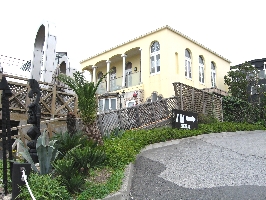

Location: A two-minute walk westward from Shichirigahama Station will bring you to a white modern building that commands a wide view of Shichirigahama facing Route 134. This is the Pavlova Memorial Hall of Kamakura. Hall: Under the arch over the front steps is a relief of Anna Pavlova and her daughter. (The hall has been closed since 1996.) Elena Pavlova (1899-1941) had come to Japan after the Russian Revolution and lived in Kamakura from the Taisho through the early Showa periods. To teach ballet, she established the first such school in Japan, and through the training of many dancers and the teaching of the beauty of this art, she laid the foundation for ballet in this country. The hall commemorates her achievements as well as those of her sister. (When the hall was open, the first floor had a tearoom where memorial picture postcards and related materials were once sold. The second floor had a display of articles Pavlova left: pictures from her active days, her favorite piano, handwritten musical scores. A video traced her career, and her singing voice could be heard on records.) A relief at the entrance included Pavlova, her mother, and her sister, who succeeded her and produced many leading ballet dancers, among them Kaitani Yaoko (貝谷八百子, 1921-91) and Tani Momoko (谷桃子, 1921-). A tablet commemorating this birthplace of Japanese ballet also hung next to the relief. |